综合概述
spring-boot作为当前最为流行的Java web开发脚手架,越来越多的开发者选择用其来构建企业级的RESTFul API接口。这些接口不但会服务于传统的web端(b/s),也会服务于移动端。在实际开发过程中,这些接口还要提供给开发测试进行相关的白盒测试,那么势必存在如何在多人协作中共享和及时更新API开发接口文档的问题。
假如你已经对传统的wiki文档共享方式所带来的弊端深恶痛绝,那么尝试一下Swagger2 方式,一定会让你有不一样的开发体验。
使用 Swagger 集成文档具有以下几个优势:
- 功能丰富 :支持多种注解,自动生成接口文档界面,支持在界面测试API接口功能;
- 及时更新 :开发过程中花一点写注释的时间,就可以及时的更新API文档,省心省力;
- 整合简单 :通过添加pom依赖和简单配置,内嵌于应用中就可同时发布API接口文档界面,不需要部署独立服务。
实现案例
接下来,我们就通过Spring Boot 来整合Swagger实现在线API文档的功能。生成项目模板
为方便我们初始化项目,Spring Boot给我们提供一个项目模板生成网站。
1. 打开浏览器,访问:https://start.spring.io/
2. 根据页面提示,选择构建工具,开发语言,项目信息等。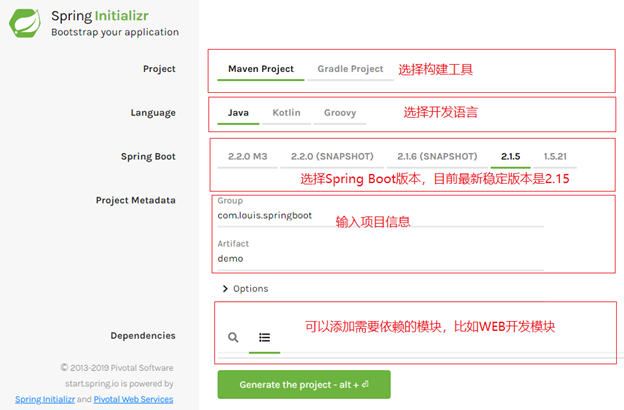
3. 点击 Generate the project,生成项目模板,生成之后会将压缩包下载到本地。
4. 使用IDE导入项目,我这里使用Eclipse,通过导入Maven项目的方式导入。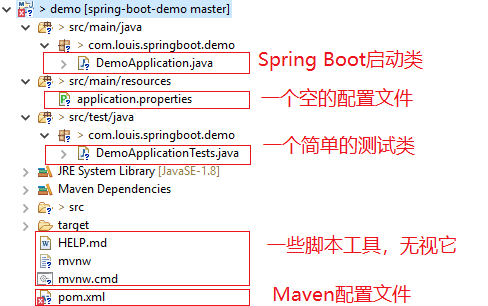
添加相关依赖
添加 Maven 相关依赖,这里需要添加上WEB和SWAGGER依赖。
WEB依赖
org.springframework.boot
spring-boot-starter-web
swagger依赖,这里选择 2.9.2 版本。
io.springfox
springfox-swagger2
2.9.2
io.springfox
springfox-swagger-ui
2.9.2 
添加配置类
添加一个swagger 配置类,在工程下新建 config 包并添加一个 SwaggerConfig 配置类。
SwaggerConfig.java
import org.springframework.context.annotation.Bean;
import org.springframework.context.annotation.Configuration;
import springfox.documentation.builders.ApiInfoBuilder;
import springfox.documentation.builders.PathSelectors;
import springfox.documentation.builders.RequestHandlerSelectors;
import springfox.documentation.service.ApiInfo;
import springfox.documentation.spi.DocumentationType;
import springfox.documentation.spring.web.plugins.Docket;
import springfox.documentation.swagger2.annotations.EnableSwagger2;
@Configuration
@EnableSwagger2
public class SwaggerConfig {
@Bean<br /> public Docket createRestApi(){<br /> return new Docket(DocumentationType.SWAGGER_2).apiInfo(apiInfo())<br /> .select()<br /> .apis(RequestHandlerSelectors.any())<br /> .paths(PathSelectors.any()).build();<br /> }private ApiInfo apiInfo(){<br /> return new ApiInfoBuilder()<br /> .title("Kitty API Doc")<br /> .description("This is a restful api document of Kitty.")<br /> .version("1.0")<br /> .build();<br /> }
添加控制器
添加一个控制器,在工程下新建 controller包并添加一个 HelloController控制器。
HelloController.java
package com.louis.springboot.demo.controller;
import org.springframework.web.bind.annotation.GetMapping;
import org.springframework.web.bind.annotation.RequestParam;
import org.springframework.web.bind.annotation.RestController;
import io.swagger.annotations.Api;
import io.swagger.annotations.ApiOperation;
import io.swagger.annotations.ApiParam;
/ 类注解 /
@Api(value = “desc of class”)
@RestController
public class HelloController {
/* 方法注解 */<br /> @ApiOperation(value = "desc of method", notes = "")<br /> @GetMapping(value="/hello")<br /> public Object hello( /* 参数注解 */ @ApiParam(value = "desc of param" , required=true ) @RequestParam String name) {<br /> return "Hello " + name + "!";<br /> }<br />}<br />
编译运行测试
右键项目 -> Run as -> Maven install,开始执行Maven构建,第一次会下载Maven依赖,可能需要点时间,如果出现如下信息,就说明项目编译打包成功了。
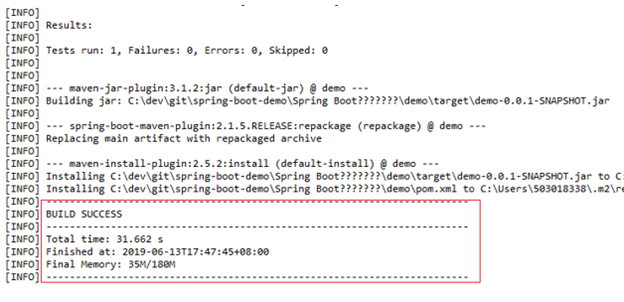
2. 右键文件 DemoApplication.java -> Run as -> Java Application,开始启动应用,当出现如下信息的时候,就说明应用启动成功了,默认启动端口是8080。
3. 打开浏览器,访问:http://localhost:8080/swagger-ui.html,进入swagger接口文档界面。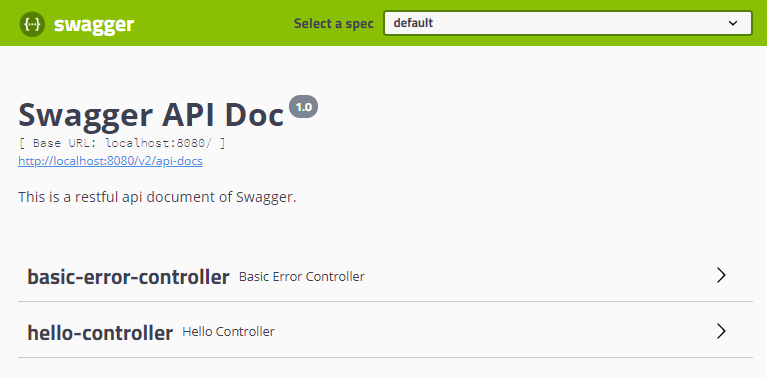
4. 展开hello-controller的hello接口,输入参数并点击执行,就可以看到接口测试结果了。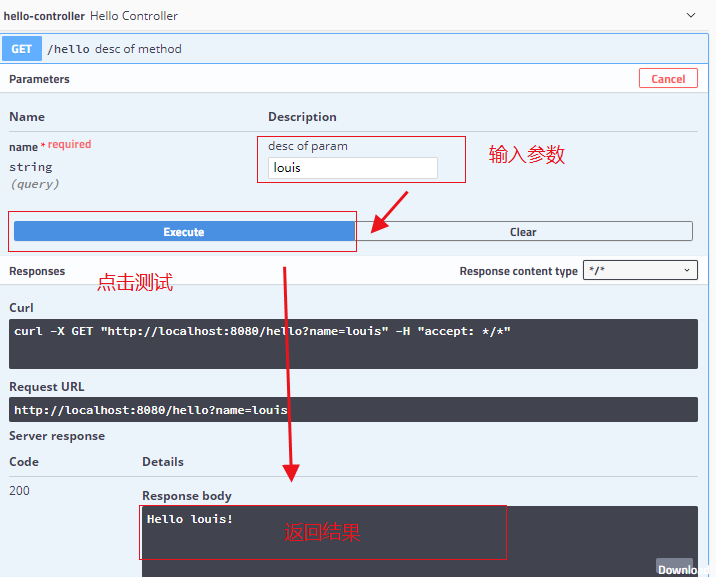
常用注解说明
swagger 通过注解接口生成文档,包括接口名,请求方法,参数,返回信息等。
@Api: 修饰整个类,用于controller类上
@ApiOperation: 描述一个接口,用户controller方法上
@ApiParam: 单个参数描述
@ApiModel: 用来对象接收参数,即返回对象
@ApiModelProperty: 对象接收参数时,描述对象的字段
@ApiResponse: Http响应其中的描述,在ApiResonse中
@ApiResponses: Http响应所有的描述,用在
@ApiIgnore: 忽略这个API
@ApiError: 发生错误的返回信息
@ApiImplicitParam: 一个请求参数
@ApiImplicitParam: 多个请求参数
更多使用说明,参考 Swagger 使用手册。添加请求参数
在很多时候,我们需要在调用我们每一个接口的时候都携带上一些通用参数,比如采取token验证逻辑的往往在接口请求时需要把token也一起传入后台,接下来,我们就来讲解一下如何给Swagger添加固定的请求参数。
修改SwaggerConfig配置类,替换成如下内容,利用ParameterBuilder构成请求参数。
SwaggerConfig.java
@Configuration
@EnableSwagger2
public class SwaggerConfig {@Bean
public Docket createRestApi(){
// 添加请求参数,我们这里把token作为请求头部参数传入后端
ParameterBuilder parameterBuilder = new ParameterBuilder();
Listparameters = new ArrayList ();
parameterBuilder.name(“token”).description(“令牌”)
.modelRef(new ModelRef(“string”)).parameterType(“header”).required(false).build();
parameters.add(parameterBuilder.build());
return new Docket(DocumentationType.SWAGGER_2).apiInfo(apiInfo()).select()
.apis(RequestHandlerSelectors.any()).paths(PathSelectors.any())
.build().globalOperationParameters(parameters);
// return new Docket(DocumentationType.SWAGGER_2).apiInfo(apiInfo())
// .select()
// .apis(RequestHandlerSelectors.any())
// .paths(PathSelectors.any()).build();
}private ApiInfo apiInfo(){
return new ApiInfoBuilder()
.title(“Swagger API Doc”)
.description(“This is a restful api document of Swagger.”)
.version(“1.0”)
.build();
}
}
完成之后重新启动应用,再次查看hello接口,可以看到已经支持发送token请求参数了。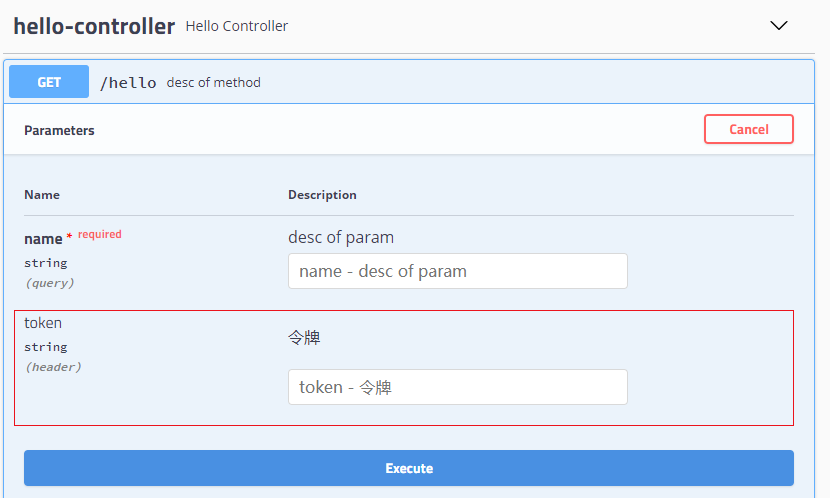
胡言乱语
前后端分离架构好,不用代码网页一起搞。
你写你页面,我写我接口,中间交由Swagger来接手。
文档风格简洁而优雅,接口测试简单又方便。
参考资料
官方网站:https://swagger.io/
使用手册:https://gumutianqi1.gitbooks.io/specification-doc/content/tools-doc/spring-boot-swagger2-guide.html
Maven仓库:https://mvnrepository.com/artifact/io.springfox/springfox-swagger-ui


